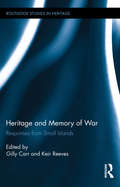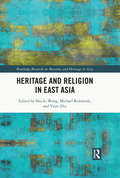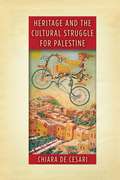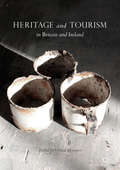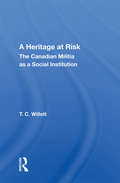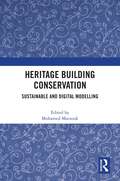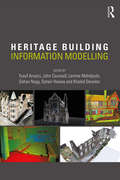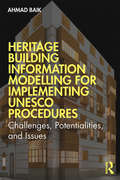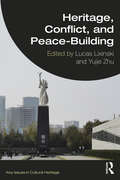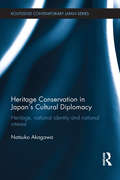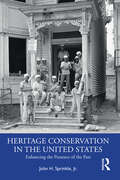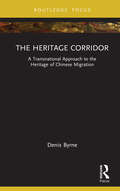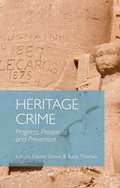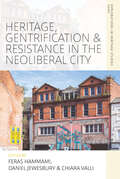- Table View
- List View
Heritage and Memory of War: Responses from Small Islands
by Gilly Carr Keir ReevesEvery large nation in the world was directly or indirectly affected by the impact of war during the course of the twentieth century, and while the historical narratives of war of these nations are well known, far less is understood about how small islands coped. These islands – often not nations in their own right but small outposts of other kingdoms, countries, and nations – have been relegated to mere footnotes in history and heritage studies as interesting case studies or unimportant curiosities. Yet for many of these small islands, war had an enduring impact on their history, memory, intangible heritage and future cultural practices, leaving a legacy that demanded some form of local response. This is the first comprehensive volume dedicated to what the memories, legacies and heritage of war in small islands can teach those who live outside them, through closely related historical and contemporary case studies covering 20th and 21st century conflict across the globe. The volume investigates a number of important questions: Why and how is war memory so enduring in small islands? Do factors such as population size, island size, isolation or geography have any impact? Do close ties of kinship and group identity enable collective memories to shape identity and its resulting war-related heritage? This book contributes to heritage and memory studies and to conflict and historical archaeology by providing a globally wide-ranging comparative assessment of small islands and their experiences of war. Heritage of War in Small Island Territories is of relevance to students, researchers, heritage and tourism professionals, local governments, and NGOs.
Heritage and Religion in East Asia (Routledge Research on Museums and Heritage in Asia)
by Shu-Li Wang Michael Rowlands Yujie ZhuHeritage and Religion in East Asia examines how religious heritage, in a mobile way, plays across national boundaries in East Asia and, in doing so, the book provides new theoretical insights into the articulation of heritage and religion. Drawing on primary, comparative research carried out in four East Asian countries, much of which was undertaken by East Asian scholars, the book shows how the inscription of religious items as "Heritage" has stimulated cross-border interactions among religious practitioners and boosted tourism along modern pilgrimage routes. Considering how these forces encourage cross-border links in heritage practices and religious movements in China, Taiwan, South Korea, and Japan, the volume also questions what role heritage plays in a region where Buddhism, Taoism, and other various folk religious practices are dominant. Arguing that it is diversity and vibrancy that makes religious discourse in East Asia unique, the contributors explore how this particularity both energizes and is empowered by heritage practices in East Asia. Heritage and Religion in East Asia enriches understanding of the impact of heritage and religious culture in modern society and will be of interest to academics and students working in heritage studies, anthropology, religion, and East Asian studies.
Heritage and Religion in East Asia (Routledge Research on Museums and Heritage in Asia)
by Shu-Li Wang Michael Rowlands Yujie ZhuHeritage and Religion in East Asia examines how religious heritage, in a mobile way, plays across national boundaries in East Asia and, in doing so, the book provides new theoretical insights into the articulation of heritage and religion. Drawing on primary, comparative research carried out in four East Asian countries, much of which was undertaken by East Asian scholars, the book shows how the inscription of religious items as "Heritage" has stimulated cross-border interactions among religious practitioners and boosted tourism along modern pilgrimage routes. Considering how these forces encourage cross-border links in heritage practices and religious movements in China, Taiwan, South Korea, and Japan, the volume also questions what role heritage plays in a region where Buddhism, Taoism, and other various folk religious practices are dominant. Arguing that it is diversity and vibrancy that makes religious discourse in East Asia unique, the contributors explore how this particularity both energizes and is empowered by heritage practices in East Asia. Heritage and Religion in East Asia enriches understanding of the impact of heritage and religious culture in modern society and will be of interest to academics and students working in heritage studies, anthropology, religion, and East Asian studies.
Heritage and the Cultural Struggle for Palestine (Stanford Studies in Middle Eastern and Islamic Societies and Cultures)
by Chiara De CesariIn recent decades, Palestinian heritage organizations have launched numerous urban regeneration and museum projects across the West Bank in response to the enduring Israeli occupation. These efforts to reclaim and assert Palestinian heritage differ significantly from the typical global cultural project: here it is people's cultural memory and living environment, rather than ancient history and archaeology, that take center stage. It is local civil society and NGOs, not state actors, who are "doing" heritage. In this context, Palestinian heritage has become not just a practice of resistance, but a resourceful mode of governing the Palestinian landscape. With this book, Chiara De Cesari examines these Palestinian heritage projects—notably the Hebron Rehabilitation Committee, Riwaq, and the Palestinian Museum—and the transnational actors, practices, and material sites they mobilize to create new institutions in the absence of a sovereign state. Through their rehabilitation of Palestinian heritage, these organizations have halted the expansion of Israeli settlements. They have also given Palestinians opportunities to rethink and transform state functions. Heritage and the Cultural Struggle for Palestine reveals how the West Bank is home to creative experimentation, insurgent agencies, and resourceful attempts to reverse colonial violence—and a model of how things could be.
Heritage and Tourism in Britain and Ireland
by Glenn HooperThis edited collection examines the natural, but sometimes troubled, relationship that exists between heritage and tourism. Chapters included focus on a selection of topics, including literary tourism, industrial heritage, conservation and care. Employing a range of historical and cultural materials, as well as an extensive number of case studies, the chapters offer an engaging overview of heritage and tourism developments across the Isles, especially in terms of recent policy and strategy initiatives, new facilities and infrastructure, as well as the different and evolving management systems currently in place. Interdisciplinary in scope, and drawing on the expertise of researchers from within both academia and industry, this volume will be of particular importance to those with interests in management and the humanities.
A Heritage At Risk: The Canadian Militia As A Social Institution
by T. C. WillettIn this comprehensive study of Canada's reserve army, the Militia, the author focuses on the regiment as both a civic and a triilitary institution that has declined in status and visibility since the country's armed services were unified in 1967. .
A Heritage At Risk: The Canadian Militia As A Social Institution
by T. C. WillettIn this comprehensive study of Canada's reserve army, the Militia, the author focuses on the regiment as both a civic and a triilitary institution that has declined in status and visibility since the country's armed services were unified in 1967. .
Heritage Building Conservation: Sustainable and Digital Modelling
by Mohamed MarzoukThis book provides a holistic perspective on the sustainable conservation of heritage buildings through outlining the factors that influence the preservation, operational performance and maintainability of heritage buildings and the application of new methodologies and technologies. Using real cases from Egypt, a country which comprises a vast number of unique heritage structures, each of which is deteriorating at its own pace, this book presents a systematic, data-based approach to manage aging and deteriorating heritage assets in a cost-effective way. The authors initially provide an overview and history of conservation and maintenance work as well as the current codes and standards that regulate the preservation of these buildings. Further chapters then cover: The technology used to digitally document heritage buildings, including LIDAR, photogrammetry, Heritage Building Information Modelling (HBIM), and Virtual Reality (VR) technologies Introducing a Maintainability Index of Heritage Buildings (MIHB) to support the decision-making and prioritization process for the maintenance of heritage buildings The adaptive reuse of heritage buildings Modelling embodied and operational energy performance Using Chatbot and Blockchain technology to support the management and preservation of heritage buildings Ultimately, this book presents a useful tool for use in heritage management and highlights how the reusability of heritage buildings is critical to the creation and survival of sustainable communities. It will be useful reading for researchers, architects, engineers and especially those involved in the management of heritage buildings.
Heritage Building Conservation: Sustainable and Digital Modelling
This book provides a holistic perspective on the sustainable conservation of heritage buildings through outlining the factors that influence the preservation, operational performance and maintainability of heritage buildings and the application of new methodologies and technologies. Using real cases from Egypt, a country which comprises a vast number of unique heritage structures, each of which is deteriorating at its own pace, this book presents a systematic, data-based approach to manage aging and deteriorating heritage assets in a cost-effective way. The authors initially provide an overview and history of conservation and maintenance work as well as the current codes and standards that regulate the preservation of these buildings. Further chapters then cover: The technology used to digitally document heritage buildings, including LIDAR, photogrammetry, Heritage Building Information Modelling (HBIM), and Virtual Reality (VR) technologies Introducing a Maintainability Index of Heritage Buildings (MIHB) to support the decision-making and prioritization process for the maintenance of heritage buildings The adaptive reuse of heritage buildings Modelling embodied and operational energy performance Using Chatbot and Blockchain technology to support the management and preservation of heritage buildings Ultimately, this book presents a useful tool for use in heritage management and highlights how the reusability of heritage buildings is critical to the creation and survival of sustainable communities. It will be useful reading for researchers, architects, engineers and especially those involved in the management of heritage buildings.
Heritage Building Information Modelling
by Yusuf Arayici John Counsell Lamine Mahdjoubi Gehan Ahmed Nagy Soheir Hawas Khaled DweidarBuilding Information Modelling (BIM) is being debated, tested and implemented wherever you look across the built environment sector. This book is about Heritage Building Information Modelling (HBIM), which necessarily differs from the commonplace applications of BIM to new construction. Where BIM is being used, the focus is still very much on design and construction. However, its use as an operational and management tool for existing buildings, particularly heritage buildings, is lagging behind. The first of its kind, this book aims to clearly define the scope for HBIM and present cutting-edge research findings alongside international case studies, before outlining challenges for the future of HBIM research and practice. After an extensive introduction to HBIM, the core themes of the book are arranged into four parts: Restoration philosophies in practice Data capture and visualisation for maintenance and repair Building performance Stakeholder engagement This book will be a key reference for built environment practitioners, researchers, academics and students engaged in BIM, HBIM, building energy modelling, building surveying, facilities management and heritage conservation more widely.
Heritage Building Information Modelling
by Yusuf Arayici John Counsell Lamine Mahdjoubi Gehan Ahmed Nagy Soheir Hawas Khaled DweidarBuilding Information Modelling (BIM) is being debated, tested and implemented wherever you look across the built environment sector. This book is about Heritage Building Information Modelling (HBIM), which necessarily differs from the commonplace applications of BIM to new construction. Where BIM is being used, the focus is still very much on design and construction. However, its use as an operational and management tool for existing buildings, particularly heritage buildings, is lagging behind. The first of its kind, this book aims to clearly define the scope for HBIM and present cutting-edge research findings alongside international case studies, before outlining challenges for the future of HBIM research and practice. After an extensive introduction to HBIM, the core themes of the book are arranged into four parts: Restoration philosophies in practice Data capture and visualisation for maintenance and repair Building performance Stakeholder engagement This book will be a key reference for built environment practitioners, researchers, academics and students engaged in BIM, HBIM, building energy modelling, building surveying, facilities management and heritage conservation more widely.
Heritage Building Information Modelling for Implementing UNESCO Procedures: Challenges, Potentialities, and Issues
by Ahmad Hamed BaikThe main aim of this book is to develop and explore the value of new innovative digital content to help satisfy UNESCO’s World Heritage nomination file requirements. Through a detailed exploration of two BIM case studies from Jeddah, Saudi Arabia, the book uniquely connects the use of Heritage BIM to the documentation methods used by UNESCO and demonstrates how this provides a contribution to both countries with heritage sites and UNESCO as an organisation. The research and practical examples in the book seek to address both the lack of a comprehensive method of submitting a nomination file to UNESCO and the lack of authentic engineering information in countries where extensive heritage sites exist. It looks at answering the following questions: How can Heritage Building Information Modelling (HBIM) be used to better maintain, protect, and record the updated information of historical buildings? How can HBIM provide innovation in creating the missing information for the assignment of UNESCO's World Heritage status? What additional value can a sustainable update of HBIM data provide for such sites? How can HBIM improve the cultural value of heritage buildings in the short, medium, and long term, as well as provide a better future for historical buildings? This book will be useful reading for researchers and practitioners in the areas of heritage conservation, archaeology, World Heritage nomination, HBIM, digital technology and engineering, remote sensing, laser scanning, and architectural technology.
Heritage Building Information Modelling for Implementing UNESCO Procedures: Challenges, Potentialities, and Issues
by Ahmad Hamed BaikThe main aim of this book is to develop and explore the value of new innovative digital content to help satisfy UNESCO’s World Heritage nomination file requirements. Through a detailed exploration of two BIM case studies from Jeddah, Saudi Arabia, the book uniquely connects the use of Heritage BIM to the documentation methods used by UNESCO and demonstrates how this provides a contribution to both countries with heritage sites and UNESCO as an organisation. The research and practical examples in the book seek to address both the lack of a comprehensive method of submitting a nomination file to UNESCO and the lack of authentic engineering information in countries where extensive heritage sites exist. It looks at answering the following questions: How can Heritage Building Information Modelling (HBIM) be used to better maintain, protect, and record the updated information of historical buildings? How can HBIM provide innovation in creating the missing information for the assignment of UNESCO's World Heritage status? What additional value can a sustainable update of HBIM data provide for such sites? How can HBIM improve the cultural value of heritage buildings in the short, medium, and long term, as well as provide a better future for historical buildings? This book will be useful reading for researchers and practitioners in the areas of heritage conservation, archaeology, World Heritage nomination, HBIM, digital technology and engineering, remote sensing, laser scanning, and architectural technology.
Heritage, Communities and Archaeology
by Laurajane Smith Emma WatertonThis book traces the development of 'community archaeology', identifying both its advantages and disadvantages by describing how and why tensions have arisen between archaeological and community understandings of the past. The focus of this book is the conceptual disjunction between heritage and data and the problems this poses for both archaeologists and communities in communicating and engaging with each other. In order to explain the extent of the miscommunication that can occur, the authors examine the ways in which a range of community groups, including communities of expertise, define and negotiate memory and identity. Importantly, they explore the ways in which these expressions are used, or are taken up, in struggles over cultural recognition - and ultimately, the practical, ethical, political and theoretical implications this has for archaeologists engaging in community work. Finally, they argue that there are very real advantages for archaeological research, theory and practice to be gained from engaging with communities.
Heritage, Communities and Archaeology (Debates In Archaeology Ser.)
by Laurajane Smith Emma WatertonThis book traces the development of 'community archaeology', identifying both its advantages and disadvantages by describing how and why tensions have arisen between archaeological and community understandings of the past. The focus of this book is the conceptual disjunction between heritage and data and the problems this poses for both archaeologists and communities in communicating and engaging with each other. In order to explain the extent of the miscommunication that can occur, the authors examine the ways in which a range of community groups, including communities of expertise, define and negotiate memory and identity. Importantly, they explore the ways in which these expressions are used, or are taken up, in struggles over cultural recognition - and ultimately, the practical, ethical, political and theoretical implications this has for archaeologists engaging in community work. Finally, they argue that there are very real advantages for archaeological research, theory and practice to be gained from engaging with communities.
Heritage, Conflict, and Peace-Building (ISSN)
by Lucas Lixinski Yujie ZhuHeritage, Conflict, and Peace-Building examines the possibilities arising from, and challenges associated with, transforming heritage from a casualty of conflict into an opportunity for peacebuilding.The contributors to this book, who hail from academia and practice, present case studies that shed light on the multifaceted factors and conditions influenced by diplomacy, nationalism, victimhood, and the roles of diverse institutional actors in fostering peace. They demonstrate the possibilities and pitfalls of the work heritage does for local communities, the nation-state, and the international community, when these different actors and their peace aspirations and agendas intersect. Looking at heritage and peace processes on all continents, the contributions in this volume amount to a compelling analytical account of how the discourses of heritage and peace connect, overlap, and diverge. They also emphasise that our shared aspiration for peace should not be taken for granted in a heritage context, and that it is incumbent upon heritage scholars and practitioners to be more intentional about the work they wish to do to promote peace.Heritage, Conflict, and Peace-Building will be of interest to scholars and practitioners working in heritage studies, transitional justice, museum studies, international relations, education, history, and law.
Heritage, Conflict, and Peace-Building (ISSN)
by Lucas Lixinski Yujie ZhuHeritage, Conflict, and Peace-Building examines the possibilities arising from, and challenges associated with, transforming heritage from a casualty of conflict into an opportunity for peacebuilding.The contributors to this book, who hail from academia and practice, present case studies that shed light on the multifaceted factors and conditions influenced by diplomacy, nationalism, victimhood, and the roles of diverse institutional actors in fostering peace. They demonstrate the possibilities and pitfalls of the work heritage does for local communities, the nation-state, and the international community, when these different actors and their peace aspirations and agendas intersect. Looking at heritage and peace processes on all continents, the contributions in this volume amount to a compelling analytical account of how the discourses of heritage and peace connect, overlap, and diverge. They also emphasise that our shared aspiration for peace should not be taken for granted in a heritage context, and that it is incumbent upon heritage scholars and practitioners to be more intentional about the work they wish to do to promote peace.Heritage, Conflict, and Peace-Building will be of interest to scholars and practitioners working in heritage studies, transitional justice, museum studies, international relations, education, history, and law.
Heritage Conservation and Japan's Cultural Diplomacy: Heritage, National Identity and National Interest (Routledge Contemporary Japan Series)
by Natsuko AkagawaJapan’s heritage conservation policy and practice, as deployed through its foreign aid programs, has become one of the main means through which post-World War II Japan has sought to mark its presence in the international arena, both globally and regionally. Heritage conservation has been intimately linked to Japan’s sense of national identity, in addition to its self-portrayal as a responsible global and regional citizen. This book explores the concepts of heritage, nationalism and Japanese national identity in the context of Japanese and international history since the second half of the nineteenth century. In doing so, it shows how Japan has built on its distinctive approach to conservation to develop a heritage-based strategy, which has been used as part of its cultural diplomacy designed to increase its ‘soft power’ both globally and within the Asian region. More broadly, Natsuko Akagawa underlines the theoretical nexus between the politics of heritage conservation, cultural diplomacy and national interest, and in turn highlights how issues of heritage conservation practice and policy are crucial to a comprehensive understanding of geo-politics. Heritage Conservation and Japan’s Cultural Diplomacy will be of great interest to students, scholars and professionals working in the fields of heritage and museum studies, heritage conservation, international relations and Asian/Japanese studies.
Heritage Conservation and Japan's Cultural Diplomacy: Heritage, National Identity and National Interest (Routledge Contemporary Japan Series)
by Natsuko AkagawaJapan’s heritage conservation policy and practice, as deployed through its foreign aid programs, has become one of the main means through which post-World War II Japan has sought to mark its presence in the international arena, both globally and regionally. Heritage conservation has been intimately linked to Japan’s sense of national identity, in addition to its self-portrayal as a responsible global and regional citizen. This book explores the concepts of heritage, nationalism and Japanese national identity in the context of Japanese and international history since the second half of the nineteenth century. In doing so, it shows how Japan has built on its distinctive approach to conservation to develop a heritage-based strategy, which has been used as part of its cultural diplomacy designed to increase its ‘soft power’ both globally and within the Asian region. More broadly, Natsuko Akagawa underlines the theoretical nexus between the politics of heritage conservation, cultural diplomacy and national interest, and in turn highlights how issues of heritage conservation practice and policy are crucial to a comprehensive understanding of geo-politics. Heritage Conservation and Japan’s Cultural Diplomacy will be of great interest to students, scholars and professionals working in the fields of heritage and museum studies, heritage conservation, international relations and Asian/Japanese studies.
Heritage Conservation in the United States: Enhancing the Presence of the Past
by John H. Sprinkle, Jr.Heritage Conservation in the United States begins to trace the growth of the American historic preservation movement over the last 50 years, viewed from the context of the civil rights and environmental movements. The first generation of the New Preservation (1966-1991) was characterized by the establishment of the bureaucratic structures that continue to shape the practice of heritage conservation in the United States. The National Register of Historic Places began with less than a thousand historic properties and grew to over 50,000 listings. Official recognition programs expanded, causing sites that would never have been considered as either significant or physically representative in 1966 now being regularly considered as part of a historic preservation planning process. The book uses the story of how sites associated with African American history came to be officially recognized and valued, and how that process challenged the conventions and criteria that governed American preservation practice. This book is designed for the historic preservation community and students engaged in the study of historic preservation.
Heritage Conservation in the United States: Enhancing the Presence of the Past
by John H. Sprinkle, Jr.Heritage Conservation in the United States begins to trace the growth of the American historic preservation movement over the last 50 years, viewed from the context of the civil rights and environmental movements. The first generation of the New Preservation (1966-1991) was characterized by the establishment of the bureaucratic structures that continue to shape the practice of heritage conservation in the United States. The National Register of Historic Places began with less than a thousand historic properties and grew to over 50,000 listings. Official recognition programs expanded, causing sites that would never have been considered as either significant or physically representative in 1966 now being regularly considered as part of a historic preservation planning process. The book uses the story of how sites associated with African American history came to be officially recognized and valued, and how that process challenged the conventions and criteria that governed American preservation practice. This book is designed for the historic preservation community and students engaged in the study of historic preservation.
The Heritage Corridor: A Transnational Approach to the Heritage of Chinese Migration (Routledge Research on Museums and Heritage in Asia)
by Denis ByrneThe Heritage Corridor argues for a transnational approach to investigating and recording heritage places that emerge from histories of migration. Addressing the material legacy of migration, this book also relates it to issues of contemporary importance. Presenting an image of the built environment of migration as one shaped by the ongoing flows of people, ideas, objects and money that circulate through migration corridors, Byrne proposes that houses and other structures built by migrants in their home villages in China over the period 1840–1940 should be seen as crystallisations of the labour, aspirations and longings enacted and experienced by their builders while overseas. Demonstrating that the material world of the migrant is distributed across transnational space, the book calls for an approach to the heritage of migration that is similarly expansive. It proposes and illustrates new methods and strategies for heritage practice. The Heritage Corridor is a book for scholars and students in the fields of critical heritage studies, migration studies and Chinese diasporic mobilities. It is designed to be accessible to heritage practitioners, readers with an interest in the material worlds of migration, past and present, and to all those with an interest in the ‘archaeology’ of transnational migration.
The Heritage Corridor: A Transnational Approach to the Heritage of Chinese Migration (Routledge Research on Museums and Heritage in Asia)
by Denis ByrneThe Heritage Corridor argues for a transnational approach to investigating and recording heritage places that emerge from histories of migration. Addressing the material legacy of migration, this book also relates it to issues of contemporary importance. Presenting an image of the built environment of migration as one shaped by the ongoing flows of people, ideas, objects and money that circulate through migration corridors, Byrne proposes that houses and other structures built by migrants in their home villages in China over the period 1840–1940 should be seen as crystallisations of the labour, aspirations and longings enacted and experienced by their builders while overseas. Demonstrating that the material world of the migrant is distributed across transnational space, the book calls for an approach to the heritage of migration that is similarly expansive. It proposes and illustrates new methods and strategies for heritage practice. The Heritage Corridor is a book for scholars and students in the fields of critical heritage studies, migration studies and Chinese diasporic mobilities. It is designed to be accessible to heritage practitioners, readers with an interest in the material worlds of migration, past and present, and to all those with an interest in the ‘archaeology’ of transnational migration.
Heritage Crime: Progress, Prospects and Prevention
by Louise Grove Suzie ThomasBringing together leading academics and practitioners from across the globe, this unique collection explores the emerging field of heritage crime studies. Moving beyond the traditional focus on illicit antiquities, the volume identifies the diversity of crimes that affect heritage and outlines various approaches to prevention.
Heritage, Gentrification and Resistance in the Neoliberal City (Explorations in Heritage Studies #5)
by Feras Hammami, Daniel Jewesbury Chiara ValliWhat happens when versions of the past become silenced, suppressed, or privileged due to urban restructuring? In what ways are the interpretations and performances of ‘the past’ linked to urban gentrification, marginalization, displacement, and social responses? Authors explore a variety of attempts to interrupt and interrogate urban restructuring, and to imagine alternative forms of urban organization, produced by diverse coalitions of resisting groups and individuals. Armed with historical narratives, oral histories, objects, physical built environment, memorials, and intangible aspects of heritage that include traditions, local knowledge and experiences, memories, authors challenge the ‘devaluation’ of their neighborhoods in official heritage and development narratives.
